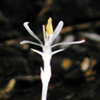SEARCH the
Gentian Research Network
and Rutgers University:
GENTIANS
Classification (newest)
List of genera
List by tribe
Gentian characteristics
Gentianales
RESEARCH
Research projects
People, addresses
Literature, publications
Links
Add info to
this site
TOPICS
Anatomy
Common names
Ecology - Natural history
GEOGRAPHY
Floras
Latin America
North America
TRIBES
Saccifolieae
_____________________
Information in other languages:
_____________________
This page
is maintained
by Dr.
Lena
Struwe
(e-mail),
and hosted by
Rutgers University, USA
updated: 01/19/11
|
Cotylanthera (Gentianaceae: Exaceae) |
 |
||||||||
|
Latin name and synonyms: Cotylanthera Bl. Etymology: The Greek word kotyle means a small cup or bowl, and anthera flower, so the meaning is "cup-shaped flower". Species: There are 4 species in this genus. Distribution: Cotylanthera is distributed mainly in Southeast Asia, from Malesia (New Guinea to the Philippines) and reaches the Himalayas (Yunnan, Sikkim, and Nepal). Habitat: These leafless herbs grow in decomposing leaf litter on the forest floor. Characteristics: Small, saprophytic, non-green herbs with not or sparsely branched stems. Leaves scale-like. Inflorescences terminal, cymose, few-flowered, sometimes with only one flower. Flowers 4-merous, actinomorphic to slightly zygomorphic (style might be bent). Calyx with nearly free lobes, not winged. Corolla, blue to pale blue, fused closed to base, lobes oblong to narrowly oblong and spreading. Stamens inserted in corolla mouth, exserted from corolla, anthers opening with apical pore, sometimes fused. Style threadlike; stigma small, capitate. Ovary bilocular; placentas axile. Fruit probably a capsule. Seeds oblong. Evolution and related plants: Cotylanthera is closely related to Exacum. Economic uses: None known. Notes: Cotylanthera is one of several saprophytic, chlorophyll-free gentians, but it is not related to the other ones of this type: Voyria and Voyriella. Accepted species (synonyms in parenthesis) and their distribution:
Hara, H. 1975. A new species of Cotylanthera (Gentianaceae) from Philippines, with a conspectus of the genus. J. Jap. Bot. 50: 321-328. Struwe, L., J. W. Kadereit, J. Klackenberg, S. Nilsson, M. Thiv, K. B. von Hagen, & V. A. Albert. 2002. Systematics, character evolution, and biogeography of Gentianaceae, including a new tribal and subtribal classification. Pp. 21-309. In: L. Struwe & V. A. Albert (eds.), Gentianaceae: Systematics and Natural History, Cambridge University Press, Cambridge. Yuan, Y.-M., S. Wohlhauser, M. Möller, P. Chassot, G. Mansion, J. Grant, P. Küpfer, & J. Klackenberg. 2003. Monophyly and relationships of the tribe Exaceae (Gentianaceae) inferred from nuclear ribosomal and chloroplast DNA sequences. Molecular Phylogenetics and Evolution 28: 500-517. (pdf)
© L. Struwe, 2004 |
|||||||||
